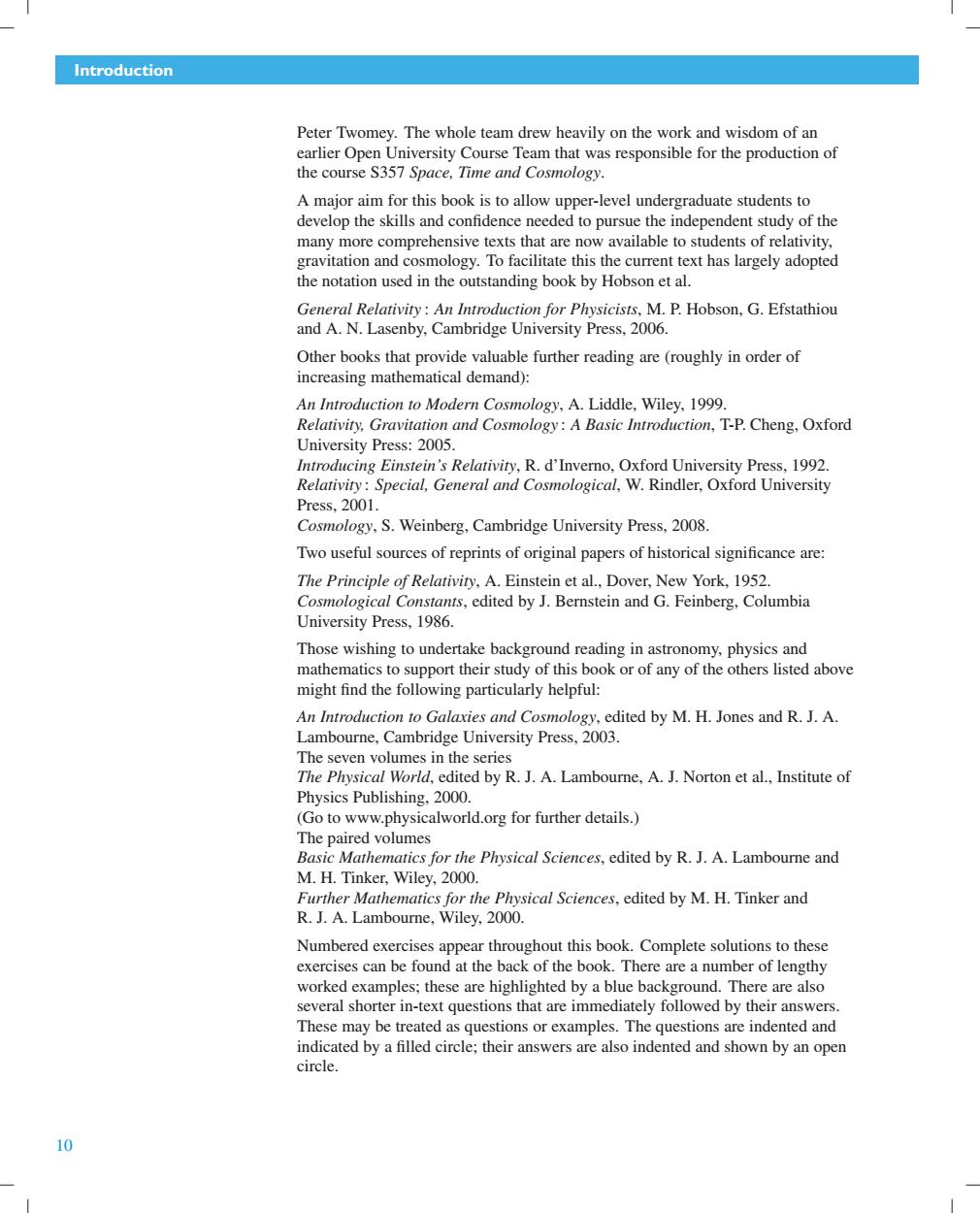正在加载图片...

Introduction Peter Twomey.The whole team drew heavily on the work and wisdom of an earlier Open University Course Team that was responsible for the production of the course S357 Space,Time and Cosmology. A major aim for this book is to allow upper-level undergraduate students to develop the skills and confidence needed to pursue the independent study of the many more comprehensive texts that are now available to students of relativity, gravitation and cosmology.To facilitate this the current text has largely adopted the notation used in the outstanding book by Hobson et al. General Relativity:An Introduction for Physicists,M.P.Hobson,G.Efstathiou and A.N.Lasenby,Cambridge University Press,2006. Other books that provide valuable further reading are(roughly in order of increasing mathematical demand): An Introduction to Modern Cosmology,A.Liddle,Wiley,1999. Relativity,Gravitation and Cosmology:A Basic Introduction,T-P.Cheng,Oxford University Press:2005. Introducing Einstein's Relativity,R.d'Inverno,Oxford University Press,1992. Relativity:Special,General and Cosmological,W.Rindler,Oxford University Press,2001. Cosmology,S.Weinberg,Cambridge University Press,2008. Two useful sources of reprints of original papers of historical significance are: The Principle of Relativity,A.Einstein et al.,Dover,New York,1952. Cosmological Constants,edited by J.Bernstein and G.Feinberg,Columbia University Press,1986. Those wishing to undertake background reading in astronomy,physics and mathematics to support their study of this book or of any of the others listed above might find the following particularly helpful: An Introduction to Galaxies and Cosmology,edited by M.H.Jones and R.J.A. Lambourne,Cambridge University Press,2003. The seven volumes in the series The Physical World,edited by R.J.A.Lambourne,A.J.Norton et al.,Institute of Physics Publishing,2000. (Go to www.physicalworld.org for further details.) The paired volumes Basic Mathematics for the Physical Sciences,edited by R.J.A.Lambourne and M.H.Tinker,Wiley,2000. Further Mathematics for the Physical Sciences,edited by M.H.Tinker and R.J.A.Lambourne,Wiley,2000. Numbered exercises appear throughout this book.Complete solutions to these exercises can be found at the back of the book.There are a number of lengthy worked examples;these are highlighted by a blue background.There are also several shorter in-text questions that are immediately followed by their answers. These may be treated as questions or examples.The questions are indented and indicated by a filled circle;their answers are also indented and shown by an open circle. 10Introduction Peter Twomey. The whole team drew heavily on the work and wisdom of an earlier Open University Course Team that was responsible for the production of the course S357 Space, Time and Cosmology. A major aim for this book is to allow upper-level undergraduate students to develop the skills and confidence needed to pursue the independent study of the many more comprehensive texts that are now available to students of relativity, gravitation and cosmology. To facilitate this the current text has largely adopted the notation used in the outstanding book by Hobson et al. General Relativity : An Introduction for Physicists, M. P. Hobson, G. Efstathiou and A. N. Lasenby, Cambridge University Press, 2006. Other books that provide valuable further reading are (roughly in order of increasing mathematical demand): An Introduction to Modern Cosmology, A. Liddle, Wiley, 1999. Relativity, Gravitation and Cosmology : A Basic Introduction, T-P. Cheng, Oxford University Press: 2005. Introducing Einstein’s Relativity, R. d’Inverno, Oxford University Press, 1992. Relativity : Special, General and Cosmological, W. Rindler, Oxford University Press, 2001. Cosmology, S. Weinberg, Cambridge University Press, 2008. Two useful sources of reprints of original papers of historical significance are: The Principle of Relativity, A. Einstein et al., Dover, New York, 1952. Cosmological Constants, edited by J. Bernstein and G. Feinberg, Columbia University Press, 1986. Those wishing to undertake background reading in astronomy, physics and mathematics to support their study of this book or of any of the others listed above might find the following particularly helpful: An Introduction to Galaxies and Cosmology, edited by M. H. Jones and R. J. A. Lambourne, Cambridge University Press, 2003. The seven volumes in the series The Physical World, edited by R. J. A. Lambourne, A. J. Norton et al., Institute of Physics Publishing, 2000. (Go to www.physicalworld.org for further details.) The paired volumes Basic Mathematics for the Physical Sciences, edited by R. J. A. Lambourne and M. H. Tinker, Wiley, 2000. Further Mathematics for the Physical Sciences, edited by M. H. Tinker and R. J. A. Lambourne, Wiley, 2000. Numbered exercises appear throughout this book. Complete solutions to these exercises can be found at the back of the book. There are a number of lengthy worked examples; these are highlighted by a blue background. There are also several shorter in-text questions that are immediately followed by their answers. These may be treated as questions or examples. The questions are indented and indicated by a filled circle; their answers are also indented and shown by an open circle. 10